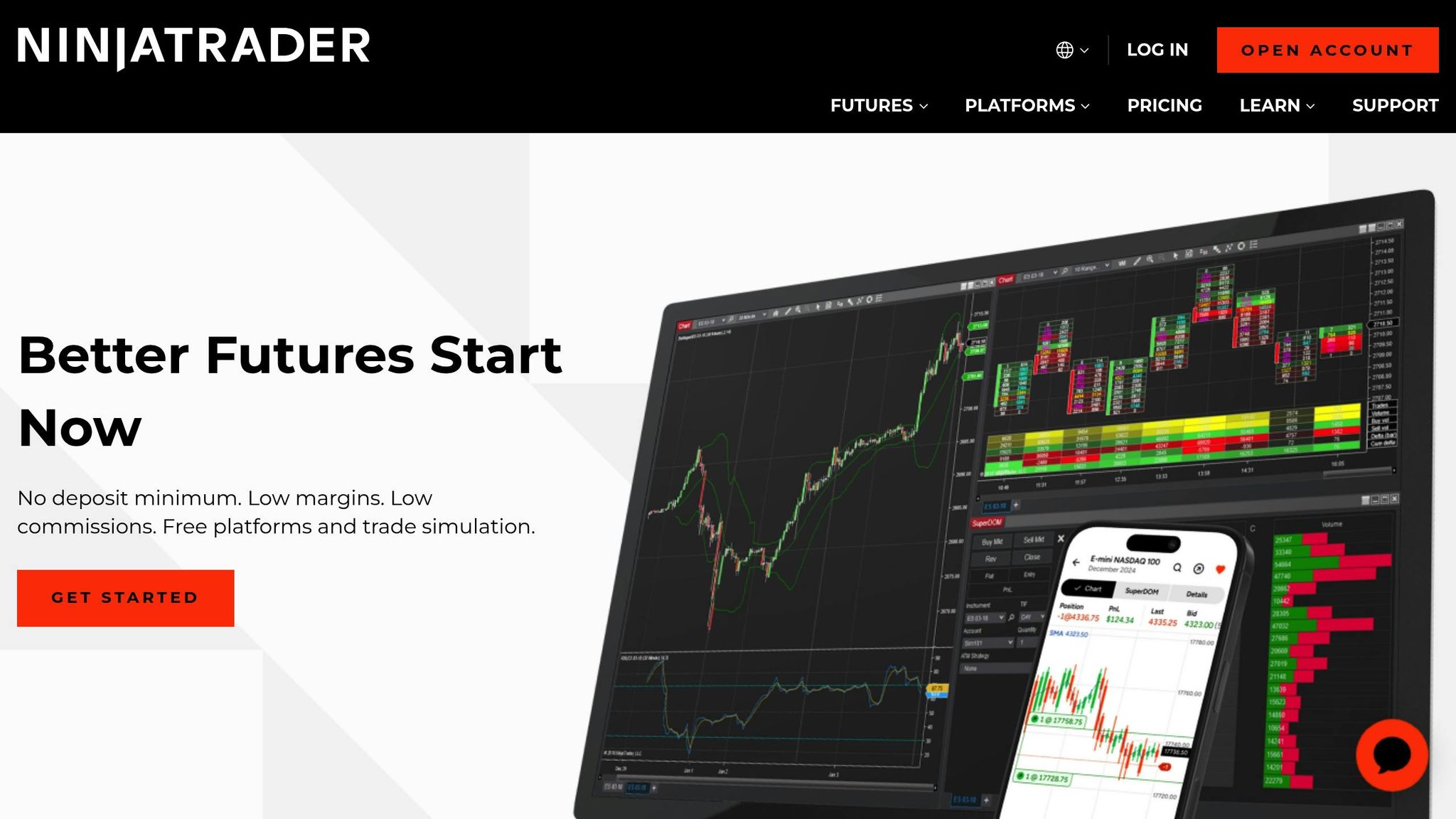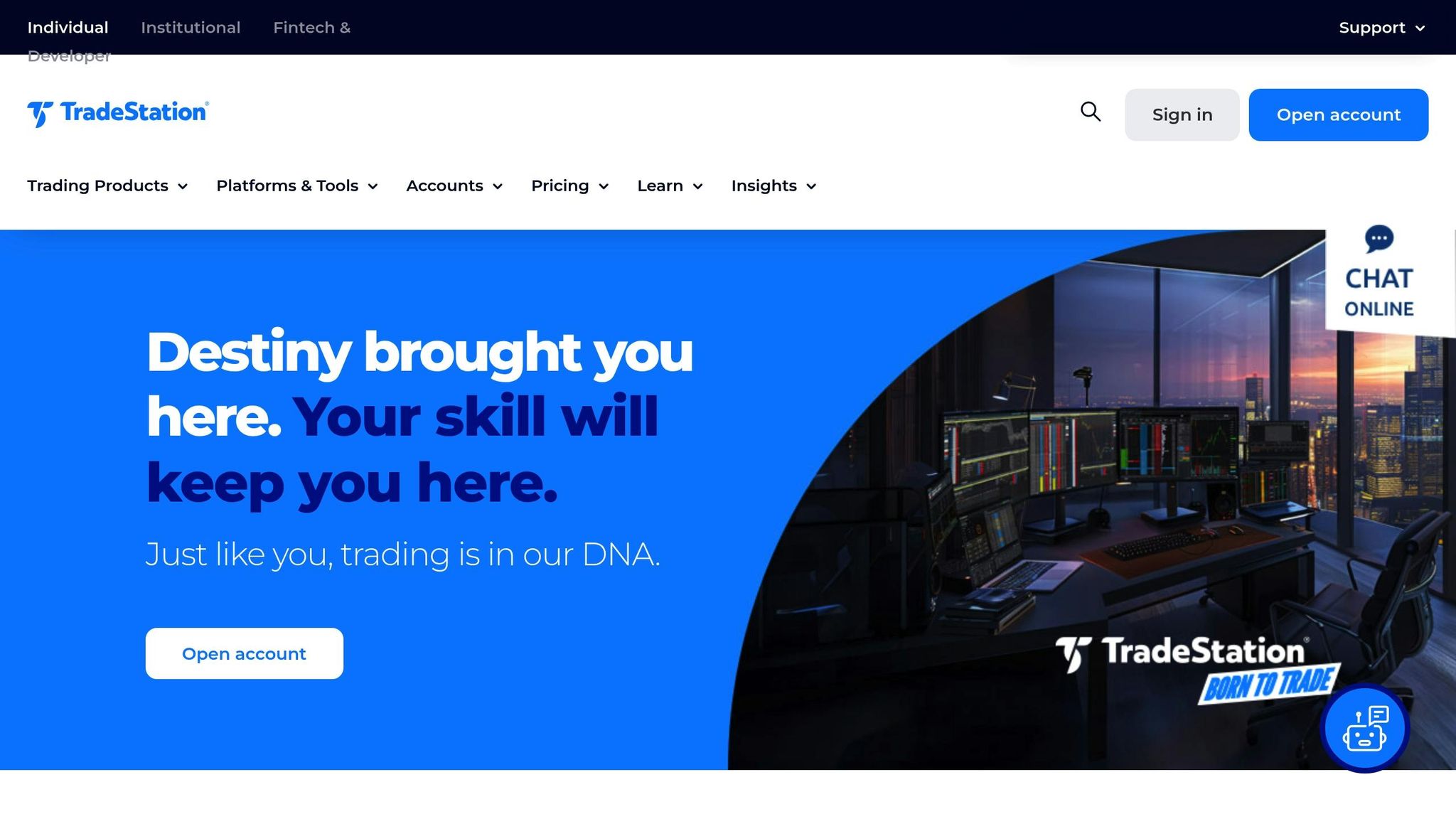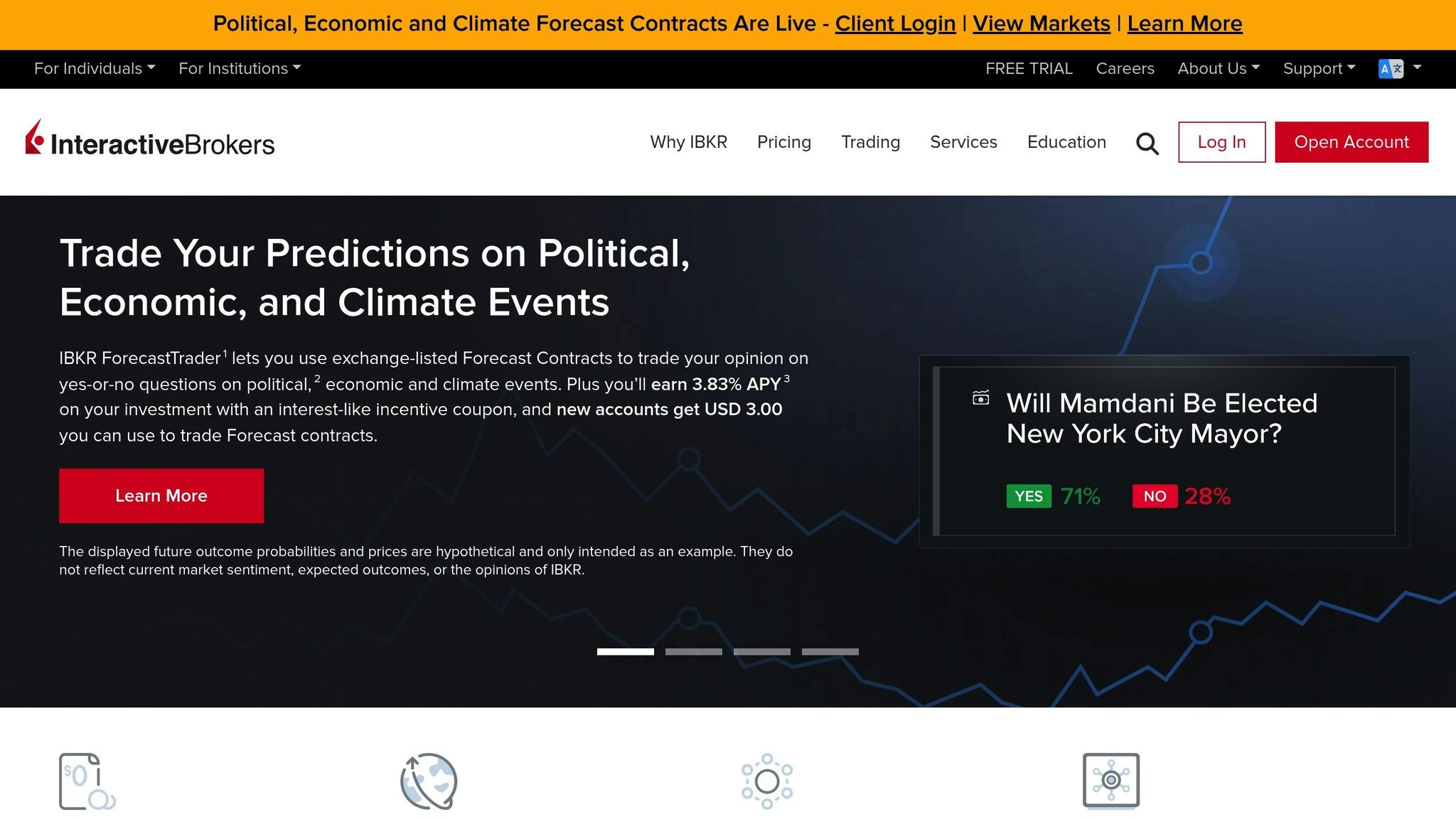If you’re looking for futures brokers with low intraday margin requirements, this guide breaks down four options that can help you trade efficiently while managing your capital. Intraday margins allow traders to control larger positions during the day using less capital compared to overnight margins, but they also come with increased risk. Here’s a quick summary of the brokers covered:
- NinjaTrader: Offers some of the lowest intraday margins, starting at $50 for Micro contracts and $500 for E-mini S&P 500 contracts. Ideal for active traders but has strict risk controls.
- AMP Futures: Known for low costs, with margins as low as $40 for Micro E-mini S&P 500. A good choice for budget-conscious traders, but policies can change without notice.
- TradeStation: Provides advanced tools for algorithmic trading. Margins vary, but Micro E-mini S&P 500 starts at $234.60. Higher costs compared to others.
- Interactive Brokers: Uses a risk-based approach for margin calculations. Best for experienced traders with diversified portfolios, but the platform can be complex for beginners.
Quick Comparison
| Broker | E-mini S&P 500 Day Margin | Micro E-mini S&P 500 Day Margin | Commission per Contract | Futures Markets |
|---|---|---|---|---|
| NinjaTrader | $500 | $50 | $0.59-$1.29 (E-mini) | 11 |
| AMP Futures | $400 | $40 | $0.25+ | Multiple |
| TradeStation | Varies | $234.60 | $1.50 | Multiple |
| Interactive Brokers | Risk-based | Risk-based | $0.85 ($0.25 micro) | 32 |
Each broker offers unique advantages depending on your trading style, volume, and risk tolerance. While low margins can maximize capital efficiency, they also amplify risk, so disciplined management is essential.
The @futuresfanatic’s Favorite Futures Brokers For Beginners
1. NinjaTrader: Better Futures Start Now

NinjaTrader is known for its aggressive intraday margin requirements, making it a popular choice among active day traders.
Minimum Intraday Margin
NinjaTrader sets low intraday margin requirements to appeal to traders. For instance, Micro contracts need just $50, while standard contracts, like the highly traded E-mini S&P 500, require $500. However, these margins can change without prior notice due to market volatility and risk management adjustments.
Asset Class Coverage
These reduced intraday margins apply across a variety of asset classes, including:
- Equities: E-mini and Micro E-mini S&P 500
- Currencies: Euro futures
- Commodities: Crude Oil
- Metals: Gold
- Bonds: US Treasury Bonds
- Agriculture: Wheat
Additionally, international products like Eurex’s Mini-Dax offer traders exposure to European indices.
Trading Hours for Reduced Margin
Intraday margin benefits are available from the start of the session until 15 minutes before the market closes. For many CME contracts, this means positions must be closed by 3:45 PM CT, ahead of the official 4:00 PM CT close. The intraday margin window typically runs from 5:00 PM CT to 3:45 PM CT the following day. Some exceptions exist, such as Wheat contracts, which end at 1:05 PM CT.
| Contract | Exchange | Intraday Margin End Time | Session Close Time |
|---|---|---|---|
| E-mini S&P 500 (ES) | CME | 3:45 PM CT | 4:00 PM CT |
| Micro E-mini S&P 500 (MES) | CME | 3:45 PM CT | 4:00 PM CT |
| Euro (6E) | CME | 3:45 PM CT | 4:00 PM CT |
| Crude Oil (CL) | NYMEX | 3:45 PM CT | 4:00 PM CT |
| Gold (GC) | COMEX | 3:45 PM CT | 4:00 PM CT |
| Wheat (ZW) | CBOT | 1:05 PM CT | 1:20 PM CT |
These timeframes are crucial for traders to plan and manage their positions effectively.
Key Trading Conditions
Margins can rise significantly during major economic announcements, reaching up to 4X the standard rates. This increase begins 15 minutes before the event and typically lasts about five minutes. Accounts that fail to meet margin requirements may face liquidation, with associated fees – $25 for the first violation and $50 for subsequent violations.
During holiday trading, early market closures eliminate intraday margin benefits. In such cases, all positions must adhere to the initial margin requirements set by the exchanges, starting 15 minutes before the market closes.
2. AMP Futures: Your Futures Trading Supercenter!

AMP Futures stands out for its low intraday margins on micro contracts, making it an attractive option for smaller traders. Here’s a closer look at their margin rates, asset coverage, trading hours, and key trading conditions.
Minimum Intraday Margin
AMP Futures is known for its competitive intraday margin requirements. For instance, the Micro E-mini S&P 500 requires just $40.00, offering an affordable entry point for futures trading. Meanwhile, the standard E-mini S&P 500 demands $400.00. Their margin structure spans both index and commodity futures. Energy traders will find Crude Oil margins at $1,658.25, while the E-mini Crude Oil is set at $832.00. For precious metals, Gold requires $1,650.00, and the E-mini Gold margin is $825.00.
Asset Class Coverage
AMP Futures supports a broad range of asset classes with reduced intraday margins. These include Micro E-mini Futures, Stock Indices, Currencies, Energies, Metals, Financials, Grains, Softs, and Meats. Micro contracts start as low as $40.00 for the Micro E-mini S&P 500 and go up to $100.00 for the Micro E-mini Nasdaq-100. Standard index futures, such as the E-mini Nasdaq-100, require $1,000.00, while the E-mini Dow and E-mini Russell 2000 are both set at $500.00.
Trading Hours for Reduced Margin
AMP Futures offers day trading margins during both U.S. Day and Overnight sessions, accommodating traders across various time zones. These reduced margins apply throughout market hours, except for the last 5 minutes before closing, when positions must be flattened or adjusted. During overnight sessions, U.S. Equity Indices margins increase to 25%, starting at 5:00 PM CST and lasting until shortly after key U.S. economic news releases.
Key Trading Conditions
Several conditions define AMP Futures’ margin policies. Margin requirements can change at any time without notice, and accounts with balances exceeding $100,000 are subject to double the standard margins. To protect traders during volatile periods, AMP Futures employs risk management tools such as CME Market Limit Market Halt Liquidation Triggers for CME indices and Risk Management Liquidation Triggers for energy products. The minimum account balance required to execute a trade matches the day trading margin, simplifying position sizing. Additionally, Top Level Risk Limits, such as maximum contract sizes, may be enforced to ensure trader safety during periods of high market volatility.
3. TradeStation: Just like you, trading is in our DNA.

TradeStation stands out with its competitive intraday margins across various asset classes, making it a strong choice for cost-conscious futures traders. Like NinjaTrader and AMP Futures, TradeStation enforces strict trading hours and risk controls to help protect its users. Here’s a closer look at its margin requirements, asset offerings, and trading conditions.
Minimum Intraday Margin
TradeStation’s intraday margin requirements differ depending on the contract type, with micro contracts typically requiring less capital. For example:
- Micro E-mini S&P 500 (MES): $234.60, compared to $2,346.40 for the standard E-mini S&P 500 (ES).
- Micro E-mini Dow (MYM): $149.70, versus $1,497.40 for the full-sized E-mini DJIA ($5) (YM).
- Light Sweet Crude Oil (CL): $1,702.00, while Micro Crude Oil (MCL) is $170.75.
- Natural Gas (NG): $1,870.50, with its micro counterpart, E-MiNY Natural Gas (QN), at $470.50.
- Gold (COMEX) (GC): $1,650.00, compared to $412.50 for E-Micro Gold (MGC).
- Currency Futures: Margins range from $742.50 for Canadian Dollar/US Dollar (CD) to $2,970.00 for Swiss Franc/US Dollar (SF).
- Interest Rate Products: Start at $206.30 for the 10-Year US Treasury Note (TY) and go up to $2,832.50 for the Ultra T-Bond (UB).
Asset Class Coverage
TradeStation supports a broad range of U.S. and select international futures, offering reduced intraday margin rates on various contracts. Here’s a breakdown of its offerings:
- Equity Index Futures: Includes popular benchmarks like the E-mini Nasdaq 100 and sector-specific contracts such as E-mini S&P 500 Technology and Financial Sectors.
- Energy Futures: Covers traditional contracts like Brent Crude Oil and Heating Oil, along with micro options like Micro Henry Hub Natural Gas and Micro RBOB Gasoline.
- Metals Futures: Includes Copper (COMEX), Platinum, and niche products like the U.S. Midwest Domestic Hot-Rolled Coil Steel Index Futures and Uranium.
- Agricultural Futures: Offers products like Corn, Soybeans, and Wheat, along with soft commodities such as Coffee "C", Sugar No. 11, and Cotton No. 2.
- Cryptocurrency Futures: Provides exposure to CME Bitcoin and CME Ether Futures, as well as their micro versions.
- Eurex Products: Extends trading opportunities internationally with select Eurex contracts.
Trading Hours for Reduced Margin
Reduced intraday margins are available from 9:00 a.m. to 4:00 p.m. ET, Monday through Friday. This schedule aligns with the core U.S. market hours, allowing traders to benefit from peak liquidity while requiring less capital during this timeframe. It’s essential to manage positions carefully before the 4:00 p.m. deadline.
Key Trading Conditions
To take advantage of reduced intraday margins, traders must adhere to specific conditions:
- Stop Orders: A valid stop order is required to use reduced margins.
- Equity Requirements: Traders must either maintain equity above the overnight margin level or close positions before the reduced margin period ends.
- Risk of Liquidation: Accounts using maximum day trade buying power may face immediate liquidation if equity falls below the intraday margin maintenance requirement.
- Policy Violations: Repeated violations of stop order rules can lead to losing access to reduced margins. Additionally, margin calls must be resolved on the same day they occur.
4. Interactive Brokers

Interactive Brokers uses a risk-based algorithm to calculate futures margin requirements. This approach tailors margin calculations to the specific risk profile of each trading portfolio, potentially offering better rates for traders with diversified positions.
Minimum Intraday Margin
Interactive Brokers determines margin requirements based on the overall risk of your portfolio. This means the margin you need can vary depending on the composition and risk level of your positions. For U.S. residents trading futures and futures options, IBKR exclusively applies this risk-based margin system. Exchange-set requirements are evaluated through its risk algorithms, which might reduce margins for traders with well-balanced portfolios. As for costs, commission rates are competitive – for instance, trading the Micro E-mini Nasdaq 100 Index (MNQ) costs $0.62 per contract. However, if you’re trading futures in an Individual Retirement Account (IRA), be prepared for significantly higher margin requirements compared to standard accounts. These dynamic calculations reflect IBKR’s ability to adapt to different asset classes and trading needs.
Asset Class Coverage
Interactive Brokers provides extensive futures coverage, though there are some limitations. Portfolio Margin is not available for U.S. commodities futures, bonds, mutual funds, or Forex positions. For U.S. stocks, OCC stock and index options, and U.S. single stock futures, IBKR employs its Theoretical Intermarket Margining System (TIMS) nightly. This system allows for more advanced risk assessments, though offsets are limited to the same asset class. Depending on the product type, IBKR supports both rules-based and risk-based margin systems. The rules-based system uses a fixed formula, while the risk-based system considers the overall risk of the portfolio.
Key Trading Conditions
Interactive Brokers enforces several key conditions for margin accounts. It operates under SEC-approved Portfolio Margin rules, which can provide leverage beyond standard Regulation T requirements for eligible accounts. Pattern Day Trading (PDT) rules apply to accounts with less than $25,000 in net liquidation value. If you make four or more day trades within five business days, you’ll be classified as a Pattern Day Trader and subject to these restrictions.
For high-risk accounts, IBKR imposes a daily "Exposure Fee." This fee is calculated using stress tests that estimate potential losses from price fluctuations. According to StockBrokers.com:
"Interactive Brokers continues to lead with unbeatable margin rates, a significant advantage for active and professional traders."
To avoid exposure fees, traders can increase their account equity, diversify their holdings, or close out short option positions. Margin requirements are also influenced by factors like your country of residence, the exchange you’re trading on, and the specific products involved.
New IBKR accounts offer flexibility with deposits. For example, a post-market deposit will update the previous day’s equity on the next trading day.
Advantages and Disadvantages
Building on the broker profiles discussed earlier, this section breaks down the key pros and cons to help you pinpoint the broker that aligns with your trading preferences and risk tolerance.
Each broker’s approach to intraday margin requirements has its own set of trade-offs, directly affecting your capital usage and overall trading experience. Understanding these can make a big difference in choosing the right fit.
NinjaTrader: Strong Platform Features with Tight Risk Controls
NinjaTrader offers $50 intraday margin for Micro contracts and $500 for E-mini S&P 500 contracts, making it an appealing choice for traders looking to maximize capital efficiency. The platform is highly regarded for its charting tools, backtesting capabilities, and automation features, earning a 4.7/5 futures score.
However, the platform’s strict risk policies are worth noting. NinjaTrader’s risk team may adjust intraday margins based on market conditions without advance notice, and execution fees apply for violations related to margin or position management. While commission rates vary depending on account type, this flexibility can be confusing for beginners.
AMP Futures: Affordable Costs with Added Flexibility
AMP Futures stands out for its low intraday margins – $400 for E-mini S&P 500 and $40 for Micro E-mini S&P 500. The broker also supports multiple trading platforms, giving users a range of options to customize their experience.
That said, AMP Futures enforces specific margin policies. Traders must either close positions or meet exchange-required maintenance margin five minutes before the daily close.
"Day Trading Margin is solely the amount required to enter into a position per contract on an intraday day basis. It is NOT the risk liquidation trigger nor the maximum amount your account can lose." – AMP Global
TradeStation: Advanced Tools with Higher Costs
TradeStation delivers a robust suite of tools for automated trading, direct market access, and custom scripting, making it ideal for algorithmic traders. However, its $1.50 per futures contract fee makes it pricier for high-volume traders.
Margin requirements are variable and must be confirmed with the trade desk. Additionally, TradeStation has strict policies regarding margin calls and liquidations:
"By trading on margin (sometimes also referred to as ‘leveraging’ or ‘gearing’) in your futures account, you acknowledge and agree that TradeStation may, in its sole discretion, and without prior notice to you, and at any time, impose a margin call and liquidate your account, in whole or part, to meet such margin call." – TradeStation
Interactive Brokers: Wide Market Access with Complexity
Interactive Brokers features a risk-based margin system, which can lower requirements for well-diversified portfolios. The broker provides access to 32 futures markets, significantly more than NinjaTrader’s 11.
Its commission rates are competitive, with tiered pricing offering lower rates for larger balances. However, the platform’s complexity can be challenging for less experienced traders. Portfolio Margin is unavailable for U.S. commodities futures, bonds, mutual funds, or Forex positions. Accounts under $25,000 are also subject to Pattern Day Trading rules, and high-risk accounts may face daily exposure fees based on stress tests.
Risk Management: A Common Thread Across Brokers
While lower margins can boost capital efficiency, they also amplify risk. Strict risk management is non-negotiable. About 90% of futures traders quit within the first 30 days due to rapid losses in this high-risk environment. Reduced margins increase leverage, which can lead to significant losses if not managed carefully.
Jack D. Schwager, a renowned expert on futures trading, stresses the importance of risk management:
"Risk management is more important than your particular approach in trading the markets. And that’s something that retail investors and traders don’t really understand."
Professional futures traders typically commit just 10% to 20% of their margin, underscoring the need for solid capital reserves to navigate volatile market conditions.
| Broker | E-mini S&P 500 Day Margin | Micro E-mini S&P 500 Day Margin | Commission per Contract | Futures Markets |
|---|---|---|---|---|
| NinjaTrader | $500 | $50 | $0.59-$1.29 (E-mini) | 11 |
| AMP Futures | $400 | $40 | $0.25+ | Multiple |
| TradeStation | Varies | Varies | $1.50 | Multiple |
| Interactive Brokers | Risk-based | Risk-based | $0.85 ($0.25 micro) | 32 |
Choosing the right broker depends on your trading volume, experience, and need for advanced tools. While low margins offer the advantage of capital efficiency, they require disciplined risk management and sufficient account buffers to avoid forced liquidations during market volatility.
Conclusion
When it comes to intraday margin strategies, the right approach depends on your trading style and comfort with risk. Each broker we reviewed brings something different to the table, catering to various trader profiles.
NinjaTrader stands out for technical traders with its detailed charting tools and automation capabilities. AMP Futures appeals to budget-conscious traders who value efficient use of capital. Interactive Brokers is a solid choice for seasoned traders, offering access to global markets and risk-based margin calculations. Meanwhile, TradeStation shines for algorithmic traders, thanks to its powerful automation and scripting tools.
While low margins can be tempting, keeping a tight rein on risk is critical. Use leverage cautiously to avoid overexposure to market fluctuations. Regularly monitor your margin levels compared to your account balance, set stop-loss orders to manage potential downturns, and keep extra funds on hand to cushion against unexpected losses. Most brokers require a minimum account balance between $500 and $5,000 to access intraday margin.
"All the focus goes into getting into the right trade, and what’s missed is that what’s most important is managing your risk and making sure you don’t take large losses".
Ultimately, choose a broker that aligns with your trading habits, platform needs, and risk management strategies. Prioritizing these factors over chasing the lowest margin rates can help you navigate the volatility of the market while minimizing the chance of significant losses.
FAQs
What are the risks of trading futures with low intraday margin requirements?
Trading futures with low intraday margin requirements can come with substantial financial risks. When margins are low, your leverage increases, meaning even small shifts in the market can result in sizable profits – or significant losses. While the potential for higher returns might be tempting, it also means you could lose more than your initial investment in a very short period, especially during volatile market conditions.
Low-margin trading can also lead to over-leveraging, which puts you at greater risk of facing margin calls if the market moves against your position. To navigate this effectively, it’s essential to evaluate your risk tolerance and have a well-thought-out risk management plan in place before diving into low-margin trading.
How do trading hours and market conditions impact intraday margin requirements for futures brokers?
Trading Hours and Market Conditions
The timing of trades and the state of the market significantly impact intraday margin requirements for futures brokers. During regular trading hours, when the market is bustling with activity and volatility tends to spike, brokers often set higher margin levels to account for the increased risks. In contrast, during quieter periods, such as after-hours trading, brokers may lower margin requirements to encourage more participation.
Market conditions also play a key role. If volatility surges or prices swing unpredictably, brokers might temporarily raise margin requirements to mitigate risk. On the flip side, during calm, low-volatility phases, these requirements are often reduced, allowing traders to better allocate their capital. Being aware of these shifts can help traders fine-tune their strategies and manage costs more efficiently.
What should I look for in a futures broker with low intraday margin requirements?
When choosing a futures broker with low intraday margin requirements, there are a few critical factors to weigh to make your trading both efficient and cost-effective. One of the most important considerations is the margin requirements, which can differ significantly between brokers. For instance, the minimum margin for popular futures like the E-mini S&P 500 can sometimes be as low as $500. Also, take a close look at the leverage offered, as higher leverage reduces the upfront capital you’ll need to trade.
Beyond margins and leverage, it’s crucial to evaluate the broker’s platform reliability, fee structure, and risk management policies. A dependable platform ensures smoother trading, while transparent fees help you avoid unexpected costs. Keep in mind that while low margins can boost potential profits, they also increase risks. Choosing a broker that fits your trading approach and comfort level with risk is key to long-term success.








